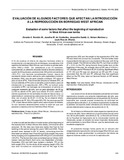Evaluación de algunos factores que afectan la introducción a la reproducción en borregas West African

Date
2009-05-08Auteur
Palabras Clave
Ovejas de pelo, West African, Introducción a la reproducción, Peso a la cubriciónHair ewe lambs, West African, Introduction at the reproduction, Mating body weight
Metadatos
Afficher la notice complèteRésumé
A fin de evaluar el efecto de algunos factores sobre la incorporación a la reproducción en borregas, se analizaron 334
registros de hembras West African, que tuvieron su primer parto entre 1980 y 2000. Se destetaron a las 10 semanas, consumiendo un alimento iniciador desde la tercera semana y a partir de 20 kg de peso, pastoreo más 300 g/d de concentrado (16% PC). Los factores considerados fueron: época de
nacimiento (enero-marzo, abril-junio, julio-septiembre y octubrediciembre,EN) y tipo de parto (simple o múltiple, TP) sobre el
peso al nacer (PN). Para el estudio del peso al destete (PD), se incluyó además el PN como covariable y para la edad y peso de
introducción a la reproducción (ER y PR), se incluyó como covariable el PD. Las borregas se incorporaron al servicio en cualquier momento del año, con un peso alrededor de 30 kg. La EN no afectó el PN, pero tuvo efecto (P<0,01) sobre PD, siendo superiores en los animales nacidos en época seca. La edad media al comenzar las cubriciones fue de 419,44 ± 137,38 días, con un peso de 30,34 ± 2,23 kg. No se observó efecto significativo de TP, EN y PD sobre ER y PR. Se concluye que EN y TP, si bien tienen efecto significativo sobre el peso al destete,
no son factores determinantes sobre la edad en que son pasadas a reproducción las hembras West African.
Información Adicional
| Otros Títulos | Evaluation of some factors that affect the beginning of reproduction in West African ewe lambs |
| Correo Electrónico | zrondon@telcel.net.ve |
| ISSN | 0798-2259 |
| Resumen en otro Idioma | In order to evaluate the effect of some factors at the beginning of the reproduction in West African ewe lambs, 334 records were analyzed. All the data was from ewe lambs that had its first lambing in the period among the years 1980 and 2000. These animals were weaned to the 10 weeks, consuming from the third week an initiator feed. From 20 kg of body weight, they were fed by foraging and supplemented with 300 g/d of concentrated (16%PC). The factors that were considered are as follows: birth season (January-March, April-June, July-September y Octuber- December, EN) and birth type (simple o multiple, TP) on the birth weight (PN). For the study of the weaning weight (PD), PN was also included as covariable and for the age to the reproduction (ER) and the weight to the reproduction (PR), the PD was taken into account as covariable. The ewe lambs were incorporated to the service in any moment of the year, with 30 kg of body weight. The EN did not affect the PN, but it had an effect (P < 0.01) on the PD, being heavier those lambs born at the beginning of the year. An average value of ER was of 419.44 ± 137.38 days, and of PR was of 30.34 ± 2.23 kg. Significant effect of TP, EN and PD was not observed on ER and PR. It was concluded that, the EN and TP, although they had significant effect on the PD, they were not decisive factors on ER female West African. |
| Colación | 445 - 448 |
| Periodicidad | Bimestral |
| Institución | Universidad del Zulia (LUZ) Universidad de Los Andes (ULA) |
| Publicación Electrónica | Revista Científica |





